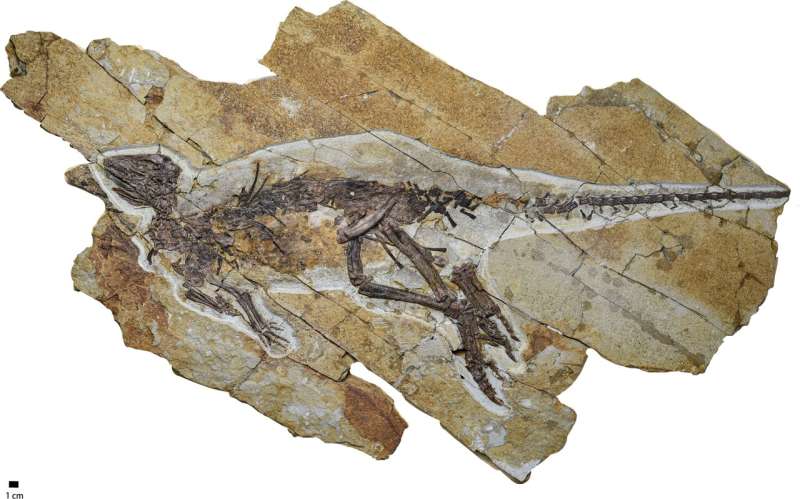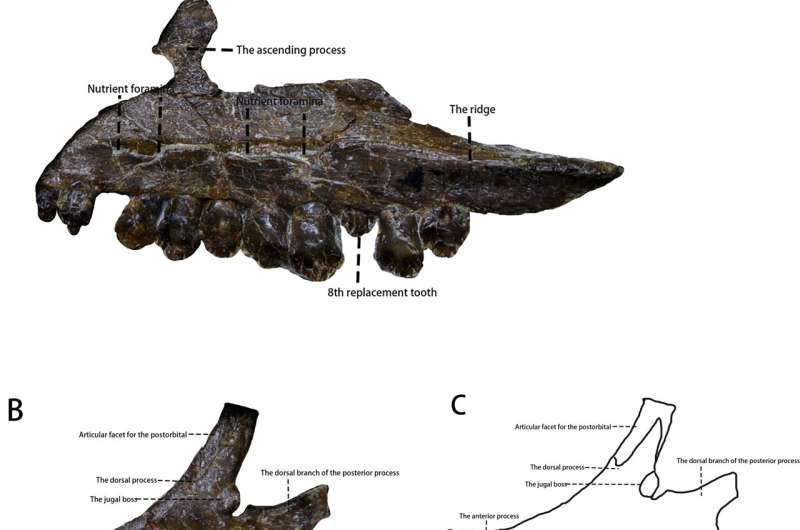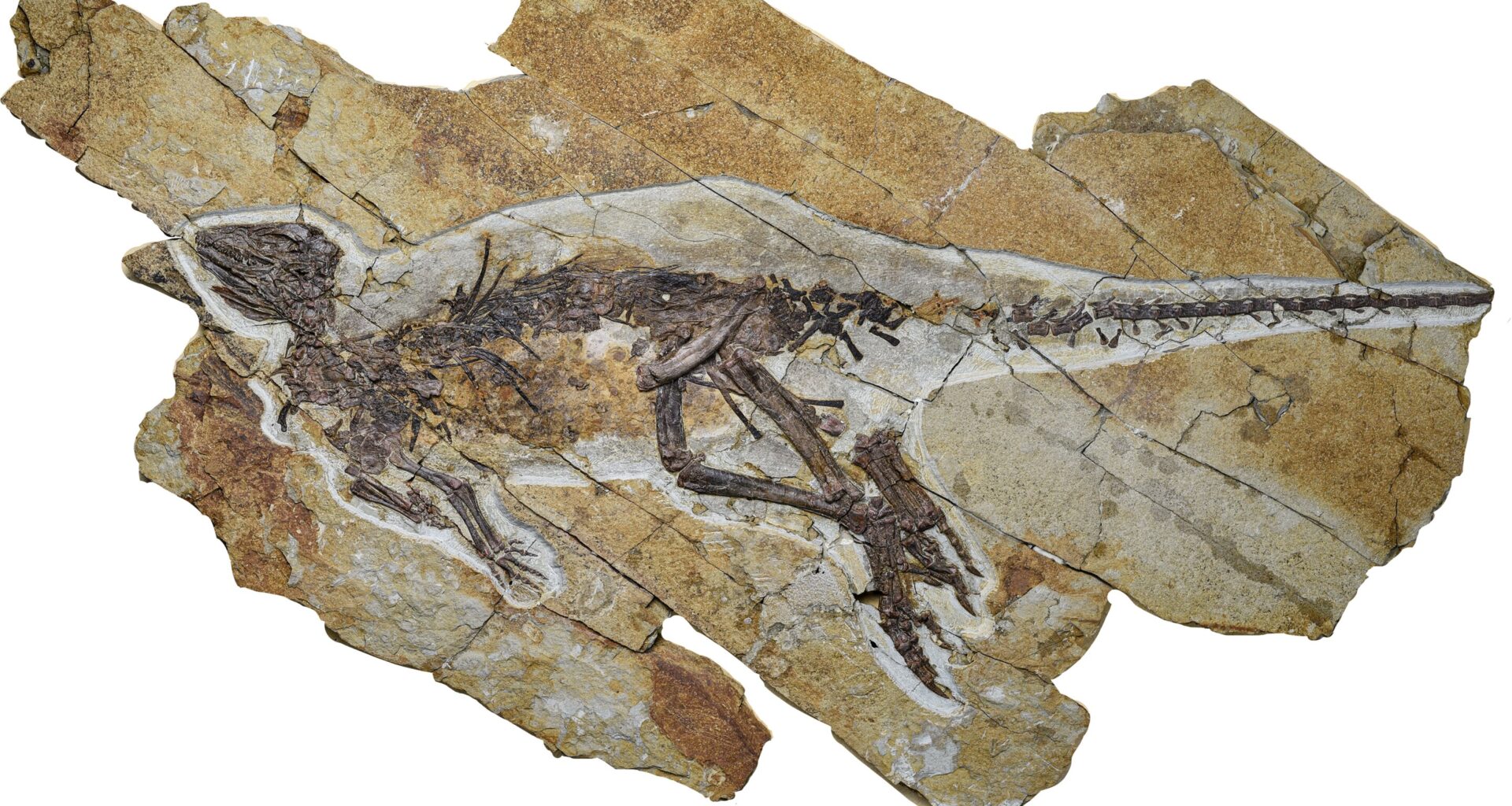
The photograph of the whole skeleton of Pulaosaurus qinglongin. Credit: PeerJ (2025). DOI: 10.7717/peerj.19664
With each new discovery in paleontology, we are gradually moving away from the Hollywood-inspired image of dinosaurs popularized by the Jurassic Park series. One of the most striking shifts has been in how we envision their appearance. Rather than the tough-skinned reptilian giants depicted on screen, many dinosaurs are now believed to have been covered in feather-like structures similar to modern birds.
Scientists are now saying that a group of herbivorous, non-avian dinosaurs tweeted like birds, instead of the expected roaring and growling, a suggestion based on the discovery of new fossilized dinosaur bones, which included parts of the voice box.
Researchers from China discovered and identified fossils of a 2-foot-long new dinosaur species, Pulaosaurus qinglong, named after “Pulao,” a mythical Chinese dragon known for its loud sound. The species belongs to Neornithischia, a subgroup of Ornithischia, which includes herbivorous dinosaurs with bird-like pelvic structures.
The fossils marked a significant find, as they became the first-ever neornithischian dinosaur specimen discovered in the Yanliao Biota—a world-renowned dinosaur fossil hotspot in northeastern China, dating to the Middle to Late Jurassic period, approximately 165–150 million years ago. The research findings are published in PeerJ.
Previous studies from the Yanliao Biota and the Asian region in general mostly focused on small theropods and early birds, with ornithischians receiving very little attention. The lack of a robust fossil record created a knowledge gap, making it difficult for researchers to trace back early diversification within Ornithischia.

The photo of several skull elements in lateral view. Credit: PeerJ (2025). DOI: 10.7717/peerj.19664
The researchers in this study discovered a remarkably well-preserved fossil of an immature Pulaosaurus qinglong in the Upper Jurassic Tiaojishan Formation in Hebei Province, northern China. The fossil included a near-complete skeleton, comprising of vertebrae, limbs, pelvis, bones of the larynx or voice box, and even some rare soft tissue structures.
The researchers conducted a phylogenetic analysis to gain a better understanding of the evolutionary family tree of Pulaosaurus qinglong. The results indicated that it was among the earliest-known neornithischian dinosaurs ever discovered. Remarkably, it is also only the second dinosaur found with fossilized larynx bones, which allowed the researchers to take a closer look at sound production and vocalization in the dinosaur. The elongated, leaf-shaped, cartilage structures in Pulaosaurus’s larynx resembled those in modern birds, suggesting possible bird-like vocal abilities.
The scientists were also curious about the dietary habits of these dinosaurs. They examined the gut cavity and found small, round pebbles and tiny impressions, which could be interpreted as plant seeds or other plant material. The teeth, jaw and tongue structure indicated that Pulaosaurus preferred chomping on soft plant foods.
The discovery of this new species offers valuable insights into the biodiversity of the Yanliao Biota and fills a missing link in our understanding of early-diverging neornithischian dinosaurs.
Written for you by our author Sanjukta Mondal,
edited by Lisa Lock, and fact-checked and reviewed by Andrew Zinin—this article is the result of careful human work. We rely on readers like you to keep independent science journalism alive.
If this reporting matters to you,
please consider a donation (especially monthly).
You’ll get an ad-free account as a thank-you.
More information:
Yunfeng Yang et al, A new neornithischian dinosaur from the Upper Jurassic Tiaojishan Formation of northern China, PeerJ (2025). DOI: 10.7717/peerj.19664
Journal information:
PeerJ
© 2025 Science X Network
Citation:
A new dinosaur species discovered in China didn’t roar, it chirped like a bird (2025, July 22)
retrieved 23 July 2025
from https://phys.org/news/2025-07-dinosaur-species-china-didnt-roar.html
This document is subject to copyright. Apart from any fair dealing for the purpose of private study or research, no
part may be reproduced without the written permission. The content is provided for information purposes only.
